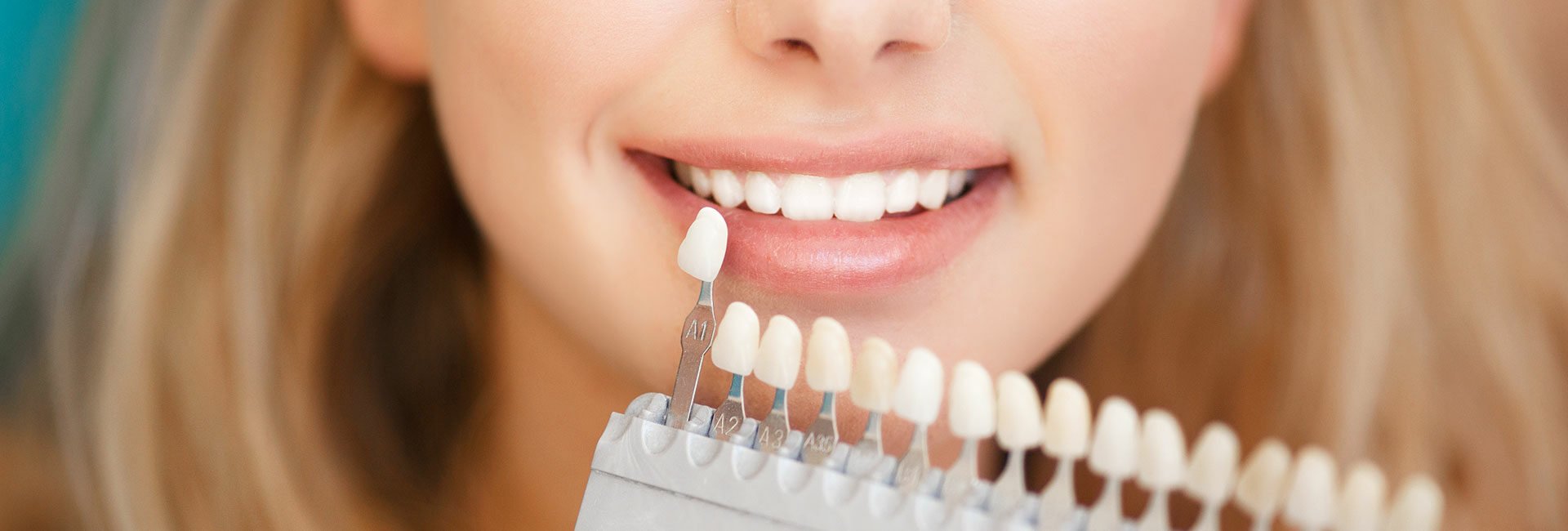
Aesthetic ceramic veneers for the front teeth
Teeth stand at the centre of people’s perception of aesthetic beauty. That’s why beautiful, white teeth with healthy tooth material is seen as a sign of beauty and elegance. Many patients yearn for a long-lasting, radiant smile, without unsightly dark tooth discolouration or misalignments. To achieve this, the right solution may in many cases be to use beautiful and completely natural ceramic veneers that protect the natural tooth material.
“Veneer” is the term used by dentists to refer to this treatment with thin layers of ceramic material. Veneer is its origins means a covering or outer-layer. They help patients to achieve a perfect, white, blemish-free, and most importantly, beautiful smile.
Various techniques are available for this treatment: Plastic veneers: easy to make, simple to apply. Disadvantages include severe discolouration of the porous surface and easy wear which means significant defects can form even after just short time periods.
Lumineers: Lumineers is the brand name for a type of very thin veneer which can usually be applied to the surface of the tooth without need for grinding down the tooth surface (“non-prep”). In the case of Lumineers and similar non-prep techniques, only wafer-thin ceramic veneers are available, as otherwise the final look makes the shape of the tooth appear too big. This leads to a large restriction of the possible treatment outcomes in terms of selecting colour and adapting the tooth shape, let alone stability problems that may arise.
Veneers: after the visible portion of the tooth is ground down, the custom-manufactured ceramic veneer, personalised for shape, colour and structure, is bonded to the prepared (ground down) tooth surface. This is the result of continuous development of the so-called “Hollywood technique”, which was developed in as early as 1937 by a dentist named C. Pincus. It was used for filming in cases of famous patients such as Marilyn Monroe or James Dean.
When can veneers bring the most advantages as a dental treatment?
In particular slight misalignments or discolourations of the teeth can be resolved using veneers. Gaps between teeth can also be closed up, and crooked teeth can be made to look straighter. In the case of all veneers treatments, the colour can be adapted to the colour of the natural teeth, and the veneers can be shaped according to each patient’s desired look.
People are often not satisfied with the shape of their teeth or have chipped teeth: treating the front teeth with veneers in these cases can often help to achieve a patient’s dream smile in terms of both shape and colour.
Our practices have their own dental laboratories, where our specialised dental technicians work with these high-strength ceramic veneers. They manufacture the veneers on an individual basis, according to each patient’s wishes.
The treatment is applied by the dentist, ensuring the highest quality results whilst protecting the teeth.

Treatment process
In the past, patients that wanted to improve the appearance of their teeth would need to have those teeth completely ground down, and a crown applied. Nowadays, many dentists use different techniques. By using innovative technologies from the field of aesthetic dentistry, we are able to reduce the tooth grinding to a minimum.
In many cases, only the uppermost tooth material needs to be roughened up, followed by a second step: application of the ceramic veneer.
A highly effective bonding process is used when applying the veneers. This special bonding process creates a particularly strong bond between tooth and veneer.
Dentist Dr. Hager manufactures veneers of high quality and resistance
Ceramic veneers are put to the test with the stresses and strains of daily life, particularly in the front tooth area. For this reason, the DR. HAGER | Dentists use a special ceramic substructure for this area, distinguished for its properties as an industrially manufactured, extremely robust and hard substance. The industrial ceramic block is precisely milled into the required shape through a CAD/CAM process. Due to the extraordinary strength of this material, patients can treat their veneers as if they were normal teeth. An aesthetically-superior silicate-based ceramic is applied to this ceramic shell by our technicians, who work by hand in finest detail and using the highest levels of precision, individually crafting each piece. Finally, this product is ‘sintered’ (heated and bonded) at over 900 degrees Celsius.
The advantage of our ceramic technology is that our dental technicians can work on the final aesthetic design with you directly, creating the exact same visual effect in the veneers as in the natural teeth surrounding them. Refraction of light, and the transparent properties of the veneer are designed to match the natural teeth. The colour of the veneer is permanent and durable, and the high-quality, bio-compatible surface has a glass-like quality, being resistant to stains or any other blemishes.
Contact Dr. Hager, your dentists in Constance, now. The competent team at our dental practice will talk to you about the possibilities, costs and prices of veneers for patients from Germany and Switzerland. Let us advise you.

“In our opinion, veneers represent the best solution in many cases in order to minimise how much grinding down of “real tooth” surfaces is required.As dentists, we are always happiest when as little natural tooth material as possible is removed for application of veneers.”
Dr. Sarah Kästle, Dentist at the Dr. Hager Dental Practice
Frequently asked questions
What are veneers?
A veneer is a thin ceramic layer, which is applied only to the visible surfaces of the tooth in a strong bonding process. The advantage they offer over crowns is that only the visible area of the tooth requires preparation (roughening and/or grinding down).
When might veneers be useful in my case?
In cases of misaligned teeth in the front tooth area, (“crooked teeth”)
In cases of visible tooth gaps
In cases of visible cracks and fissures in the tooth enamel
In cases where teeth are permanently discoloured
In cases of chipped or damaged tooth edges
In cases where the teeth are too small or underdeveloped